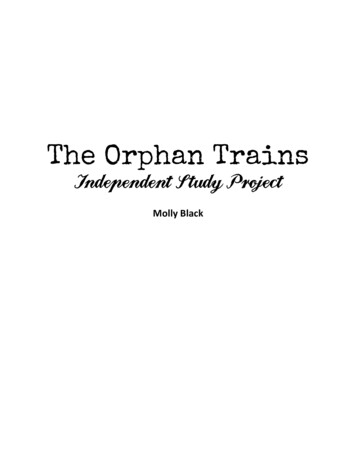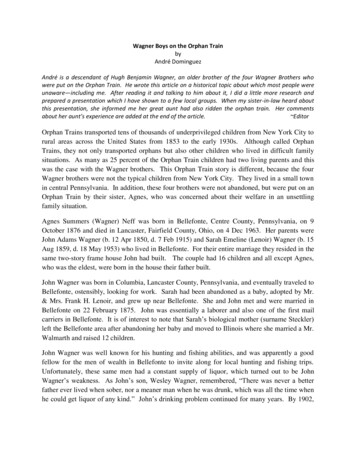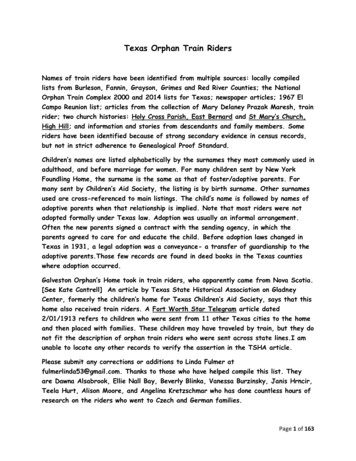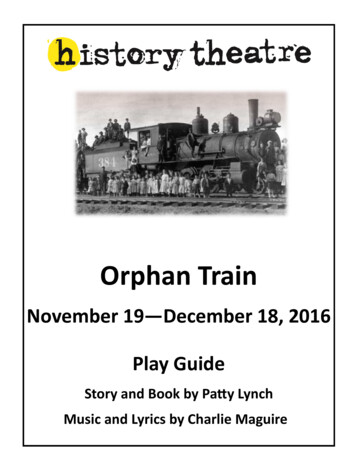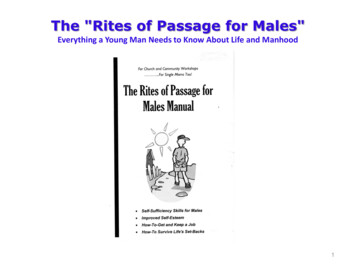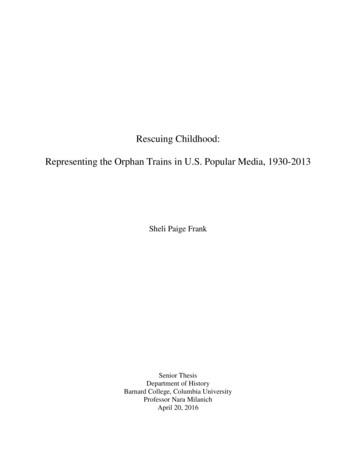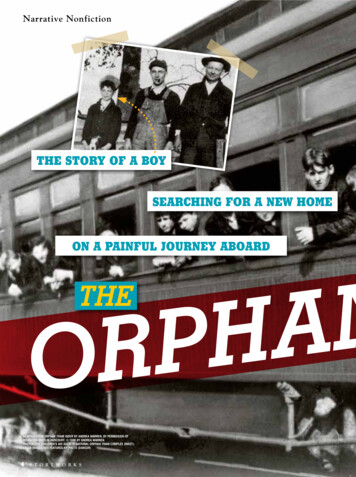
Transcription
Narrative NonfictionTHE STORY OF A BOYSearching FOR A NEW HOMEON A Painful JOURNEY ABOARDNAHPROTHEAdapted from ORPHAN TRAIN RIDER by Andrea Warren, by permission ofHoughton Mifflin Harcourt. 1996 by Andrea Warren.PHOTOS: The Children’s Aid Society; National Orphan Train Complex (inset);Gallo Images/Rex Features/AP Photo (Dancer)4s t o r y w o r k s
NIARTNBy Kim HillCompare and contrast In “The Orphan Train”UPand “Magnificent Michaela,” you will read about theCLOSE extraordinary journeys of two young people. As youread, look for similarities and differences in theirexperiences.Look forWord Nerd’s9 WORDS INBOLDithoes ul n wt d tif mo ge 9.au com paWhbea in onis haved outthina Finer ng?ll NaillibaLeew w w . s c h o l a s t i c . c o m / s t o r y w o r k s OCTO B E R 2 0 1 35
6s t o r y w o r k sBettmann/Corbis (TOP); Library of Congress (RIGHT)It was March 1926. Leewas 8. He was on a trainNew York City was a landof opportunity for newheading west. His twoimmigrants. But life was harshyounger brothers, Geraldfor the poor. Thousands ofand Leo, were with him.kids lived on the streets. Thepublic often viewed them asSo were 47 other kids whofuture criminals and as pests.had no parents or whose parentscould not care for them. A matronwas in charge of the kids. Her jobwas to keep them safe.Lee’s mom had died. His dad wasout of work and could not care forhis kids. For two years, Lee had livedin a New York City orphanage. Itwas an awful place. There was neverenough to eat. Fights broke out.Now, Lee and his brothers werebeing sent west to find new homes.“This is an orphan train,” the matrontold Lee. “You’re very lucky to beon it.”Lee didn’t think so. The otherkids might have been ready for new homes.a job or got sick, there was often nowhere toBut Lee missed his dad, who had come toturn for help. Some kids went to orphanages.the train station to see them off. With tearsOthers wound up on the streets. They beggedin his eyes, his dad had given Lee a pinkand stole to survive. Many people saw theseenvelope with his address on it and told him“street urchins” as dangerous pests.to write. Lee was sure his dad wanted themBut others wanted to help. In 1853,back.Charles Loring Brace founded the Children’sOn the train, Lee thought of how gladAid Society. This group gave food, shelter,his dad would be when the boys came backand schooling to New York City’s abandonedto him.kids. Brace came to believe that the dirt andcrowds of city life were unhealthy for kids.Children on the StreetsHe had read of a program in Europe in whichThe orphan-train program began inpoor kids were sent to the countryside to find1854. At the time, thousands of kids lived ingood homes. He thought a similar idea mightorphanages and on the streets in New Yorkwork in the U.S. At the time, thousands ofand other eastern cities. Like Lee, many ofAmericans were heading to the frontier tothese kids were not, in fact, orphans. Theirstart new lives as farmers and ranchers. Braceparents were alive but could not care forbelieved that these farm families could carethem.for needy kids. And what better way to bringCity life was hard for the poor. Many werekids to new towns than on America’s newcross-country railroad system?recent immigrants from Europe. They workedBrace called his plan “placing out.” Trainslong hours for low pay. When a parent lost
would bring groups of kids totowns in the West. Residentswould gather to pick a child.In 1854, Brace testedhis plan with 46 kids. Theywent to Michigan with twochaperones. By the end ofthe trip, every child had anew home. Soon, thousandsof kids were riding orphantrains each year.Pink EnvelopeMost kids were told onlya night or two in advancethat they would be goingwest. They were givena bath and new clothes.Lee and his brothers weredressed up in knickers,neckties, and suit jackets.Girls wore new dresses. Matronswarned the kids to keep their clothes neat.That was not easy on a train trip thatcould last a week or more.That first night, Lee took off his jacket.He laid it out neatly. He checked to makesure the envelope his dad had given him wassafe in the pocket. It was. But when he wokeup, the envelope was gone. Lee searched forit. He called the matron for help. She toldhim to get back in his seat. “Where you’regoing, you won’t be needing that envelope,”she said. “You must forget it.”Lee knew she had taken it; she wantedhim to forget about his dad. Lee felt helpless.First his mom had died. Then he’d spent twoyears at an orphanage. Now he’d lost his onlylink to his dad. “Nights on that train, I’d liethere with tears rolling down my cheeks,”Lee later said, “my heart breaking again andagain. How had I lost so much?”Finding a HomeEven before an orphan train set off,the Children’s Aid Society was working toline up families in towns along the route.Notices of “homes wanted for children” ranin newspapers. When the train stopped in atown, the matrons led the kids toa gathering place, such asa church or hotel. Thenpeople would line up tomeet the kids. Familieswould make their choices.Kids who weren’t pickedgot back on the train. Theydid this again and againuntil someone chose them.Many of these trips endedwell. Needy kids found goodhomes. But some familiesjust wanted free farm labor orSome orphaned orsomeone to clean the house.poor kids lived inAgentsfor the Children’s Aidorphanages like thisSociety were supposed to keepone. Food (and love)was scarce.track of every child. That way,they could get kids out of badw w w. s c h o l a s t i c . c o m / s t o ry w o r k s N O V E M B E R / D E C E M B E R 2 0 1 37
After breakfast,the Naillings tookLee to town. Theystopped at eachhouse along theway. Each time,they introducedLee as their “newson.” Lee’s plans torun away faded.situations. Butthe system failedsometimes. Somekids were treatedpoorly. Some ranaway.The JourneyEndswrite to winWhat do Lee’s and Michaela’s experiences have in common? What wisdom do youthink they could share with other orphans? Send two to three paragraphs to“Orphan Train Contest” by Jan. 15, 2014. Ten winners will each receive afind ancopy of Home of the Brave by Katherine Applegate. See page 2 for details.activityonline!8s t o r y w o r k sAll photos: Children’s Aid SocietyAt first, Lee’strip seemed to beheading that way.Riding theTrainAfter several stops,half the kids hadThe lastbeen picked—orphan train leftbut not Lee.New York in 1929.In one town,By then, thereNew York kids with their matron anda farmer feltwere new programsa male chaperone prepare to go westLee’s musclesto help the poor.(above). The orphan trains, started byand stuck hisFewer kids woundCharles Loring Brace (left), led to thecreation of today’s foster-care system.hand in Lee’sup on the streets.mouth to feel hisNearly 200,000teeth. It made Lee angry.kids rode the orphan trains. There are noAt the end of a grueling week, the trainstudies to show what happened to them.stopped in Clarksville, Texas. One coupleMany did go on to lead happy lives. Otherschose Gerald. Another chose Leo. They tooksuffered.Lee too, but after a few days, they decidedLee never reunited with his dad. But lifeLeo was all they could handle. Next, Leewith the Naillings was good. Lee’s brotherslived with an elderly couple. But that didn’tlived nearby. He saw them often. He went tolast either.college. He married and became a father, aThen Lee met Ben and Ollie Nailling. Atgrandfather, and a great-grandfather.their home, he was astonished to have his“I’ve always felt that I had a guardianown bedroom. Still, he did not speak to themangel watching over me,” said Lee, whothe first day. The next morning, he woke updied in 2001. “When I got off that train into the smell of biscuits, ham, bacon, eggs, andTexas, I was a bitterly unhappy little boy. Thepotatoes. It was the most food he had evergood Lord saw to it that I ended up with theseen at one time.Naillings. That was where I belonged.”
biographyMagnificent MichaelaOrphaned by a war, this amazing teen made her dream come trueGallo Images/Rex Features/AP PhotoMichaela DePrince cantwirl and leap in the air.She wears lovely tutusand tiaras. In July 2012,she became a professionalballet dancer.It was a dream come true.But Michaela’s life was not alwayshappy. She was born during a civil war inSierra Leone, a country in Africa. Whenshe was 3, soldiers killed her dad. Then hermom starved to death.Michaela was sent to anorphanage. The workers thereteased her because she has acondition that turns patches of herskin white. They thought she was theleast likely to be adopted out of all27 kids there. So they called her“Number 27.”Michaela’s best friend,Mia, was “Number 26.”The two girls shareda sleeping mat.When Michaelahad nightmares,Mia would tell her stories. The friendsdreamed that one day they would beadopted and have a mom who lovedthem.One day, Michaela was playing inthe yard. A page from a magazineblew against the fence. On it wasa photo of a beautiful ballerina.Michaela hoped that one dayshe’d be as happy as the dancer.She kept the photo.When Michaela was 4, a couple fromNew Jersey decided to adopt Mia. Theorphanage workers told the couple thatno one would ever want Michaela. Thecouple proved them wrong. They adoptedboth girls.Michaela’s new parents signed her up fordance classes. She has beendancing ever since.At times, it’s been hard.When Michaela was 13,she lived far from home at aballet boarding school. Shepracticed 6 to 10 hours aday, sometimes 7 days aweek.Her work paid off.She earned scholarshipsto ballet school. Shehas won competitions.Now the girl who oncedreamed about a magazinephoto appears in magazinesherself. She was on DancingWith the Stars. And she was in anaward-winning movie, First Position.In August 2012, she joined theprestigious Dance Theatre of Harlem inNew York City.Michaela hopes to start a ballet schoolin Sierra Leone one day.“My life is proof that no matter whatsituation you’re in,” she says, “as long as youhave a supportive family, you can achieveanything.” –Blair Rainsfordw w w. s c h o l a s t i c . c o m / s t o ry w o r k s N O V E M B E R / D E C E M B E R 2 0 1 39
Train The last orphan train left New York in 1929. By then, there were new programs to help the poor. Fewer kids wound up on the streets. Nearly 200,000 kids rode the orphan trains. There are no studies to show what happened to them. Many did go on to lead happy lives. Others suffere
